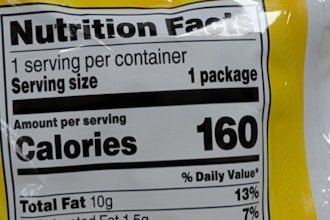
In October 2023, Kellogg Co. embarked on a bold rebranding journey, splitting its iconic 117-year-old operations into two distinct entities. The larger division emerged as "Kellanova," with a mission to drive growth and innovation in the global snack market.
A year later, Bynder, global leader in Digital Asset Management, takes a closer look at the initial impact of the Kellanova rebrand on consumer loyalty, brand recognition, and market positioning.
Through insights from Bynder’s research and expert commentary, both the opportunities and obstacles in Kellanova’s first year provide lessons for companies considering a similar move.
A fresh identity with historic roots
Manisha Mehta, senior PR and communications manager at Bynder, provided context to the brand’s move:
“Kellogg’s decision to rebrand its global snacks division as Kellanova stemmed from a strategic vision to modernize its image and strengthen its position in the fast-growing snacking market. The name 'Kellanova' blends Kellogg’s with 'nova,' Latin for 'new,' creating a brand that nods to its heritage while signaling a fresh beginning.
Kellanova embodies the idea of legacy combined with forward momentum, setting the stage for a new chapter in global snacking. But a rebrand like this requires finesse; it’s about honoring the brand’s past while building credibility and trust in its new identity. The company’s challenge lay in preserving the trusted Kellogg’s name while differentiating itself in the global snack sector.”
Consumer response: “Kelloggs” is more popular than “Kellanova”
Despite the optimism around Kellanova, the first year has revealed challenges, particularly in consumer recognition. Bynder’s research shows that consumers overwhelmingly still associate with “Kellogg’s,” with global search volumes reflecting this loyalty.
Over the past year, searches for the correct spelling of “Kelloggs” reached 3.22 million, while the common misspelling “Kellogs” amassed 4.82 million searches, totaling over 8 million for the legacy brand. In contrast, searches for “Kellanova” numbered just over 1.5 million — a stark contrast indicating the persistence of the original brand’s power in the consumer psyche.
Exact worldwide search volume data from the past year:
- “Kelloggs”: 3,220,212
- “Kellogs”: 4,815,512
- “Kellanova”: 1,561,112
Manisha added:
“The search data reveals an intriguing pattern: the misspelled 'Kellogs' outpaces the correct 'Kellogg’s' in search volume, highlighting how the original brand name was, despite iconic, also prone to errors — a factor that actually supports the shift to a simpler name like Kellanova. By sidestepping these spelling challenges, Kellanova positions itself as more accessible and memorable. Yet, the strong search volume tied to 'Kellogg’s' underscores enduring loyalty to the legacy name, signaling the challenge ahead for Kellanova in capturing that brand allegiance.
Despite these initial hurdles, the rebrand offers Kellanova a unique chance to redefine itself, free from the cereal-specific associations of Kellogg’s, and establish a fresh narrative as a global snacking leader. However, Kellanova’s path is not without risk: consumer attachment to the Kellogg’s name, cultivated over more than a century, poses a genuine challenge. Early data suggests that this loyalty may not easily transfer, indicating that while Kellanova has gained a platform for reinvention, it will need strategic efforts to truly shift consumer loyalty.”
Long-term potential of "Kellanova" and short-term obstacles
“Looking to the future, long-term success for Kellanova will depend on whether the brand can maintain the values and familiarity that defined Kellogg’s while offering a fresh, distinct experience. While Kellogg’s carries equity that’s difficult to replicate, Kellanova has the chance to forge connections that feel more relevant to today’s consumers.
However, the downside is clear: Kellanova will face the difficult task of building loyalty from the ground up, an endeavor that will likely require ongoing investment in consumer engagement and brand storytelling. It also risks alienating long-time consumers who may feel disconnected from the new identity, losing valuable heritage-driven brand equity. Balancing these pros and cons will be critical as Kellanova scales its efforts to become a household name on par with its predecessor.”
Top 3 lessons in legacy and evolution
Manisha offered several lessons learned from the rebrand, based on its short and long-term pros and cons:
1. Reposition boldly, but communicate clearly to minimize confusion
- Pro: “Rebranding offers a unique opportunity to redefine and expand a brand’s identity, as Kellanova has done by positioning itself as a global snacking leader separate from its cereal heritage.”
- Con: “However, consumer confusion is common during such transitions, especially with a name as recognizable as Kellogg’s. To address this, marketers should ensure clear, consistent messaging that explains the rebrand’s purpose and benefits, using storytelling to create an emotional bridge from the old identity to the new one.”
2. Leverage a unique identity to stand out, but prepare for slow initial traction
- Pro: “Kellanova’s new identity is designed for global relevance and long-term growth, with flexibility to evolve within the snack market.”
- Con: “This newness, however, may lead to slow initial traction as consumers adjust, particularly for those loyal to the Kellogg’s brand. To combat this, marketers can implement phased rollouts, using familiar elements from the legacy brand in early stages to ease the transition while gradually introducing new visual and messaging elements that emphasise the rebrand’s modern appeal.”
3. Embrace expansion potential, but reinforce brand value to counter potential loyalty loss
- Pro: “The rebrand enables Kellanova to escape the spelling challenges of “Kelloggs” while creating a memorable name for new, international audiences.”
- Con: “Yet, rebranding means risking the loss of heritage-driven brand equity, which takes years to rebuild. Marketers can address this by highlighting the core values and product quality associated with the original brand while adding a fresh narrative that appeals to new audiences. Brand equity-building initiatives, like loyalty programs and community engagement, can help solidify consumer trust in the rebranded entity.”
Manisha concluded, “As Kellanova looks to establish its name in the global snack market, the coming years will be pivotal in defining its standing in the eyes of consumers. The lessons learned from Kellanova’s rebrand underscore the complexity of evolving a legacy brand, but provides a glimmer of hope for potential as the years go on.”
Ed. note: This article has been updated to clarify that Kellogg Co. split into two companies, rather than the “Kellogg’s” brand, and that most of the company’s food brands became part of Kellanova.






















